This article was co-authored by Eric Baron, DO. Dr. Eric P. Baron is a staff ABPN (American Board of Psychiatry and Neurology) board certified Neurologist and a UCNS (United Council for Neurologic Subspecialties) Diplomat board certified in Headache Medicine at Cleveland Clinic Neurological Institute, Center for Neurological Restoration – Headache and Chronic Pain Medicine, in Cleveland, Ohio. With over 15 years of experience practicing medicine, he specializes in helping patients with headaches, migraines, and facial pain. Dr. Baron holds a BS in Biology from the University of Toledo and a DO from The Ohio University Heritage College of Osteopathic Medicine. Following his medical education, he completed his neurology residency and fellowship in headache medicine at Cleveland Clinic. Dr. Baron has authored publications in journals such as The Journal of Headache and Pain and was named one of “America’s Top Physicians."
There are 40 references cited in this article, which can be found at the bottom of the page.
wikiHow marks an article as reader-approved once it receives enough positive feedback. In this case, 100% of readers who voted found the article helpful, earning it our reader-approved status.
This article has been viewed 596,319 times.
The best treatment for people who suffer frequent or severe migraine headaches is prevention. There are a number of things you can do to stop a migraine before it starts, which is best done by finding your personal triggers for migraines. Lifestyle changes have been proven to reduce the severity and frequency of migraines in many people. You can follow a few simple steps to find your migraine triggers and help prevent migraines.
Steps
Controlling Common Triggers
-
1Prevent low blood sugar. Low blood sugar, also known as hypoglycemia, can cause migraines. It is brought on by lack of nutrients or by eating too many refined carbohydrates, which turn to sugar in the blood. Small frequent meals are important if you want to control your blood sugar. Do not skip any meal throughout the day. Avoid refined carbohydrates like sugar and white bread. Whole grain breads should be fine.[1]
- For each of your small meals, choose options such as fresh fruits and vegetables with a protein like an egg or lean meats. This will help you keep your blood sugar steady throughout the day.[2]
-
2Avoid foods with tyramine and nitrites. Tyramine is a substance that can release a chemical in your brain called norepinephrine, which can lead to headaches.[3] There are many common foods containing tyramine or nitrites. Foods such as eggplant, potatoes, sausage, bacon, ham, spinach, sugar, aged cheese, beer, and red wine contain these compounds.[4]
- Other tyramine-containing foods include chocolate, fried food, bananas, plums, broad beans, tomatoes, and citrus fruit.
- Foods with high levels of seasoning such as MSG or artificial additives might also contribute to triggering a migraine.[5]
- Soy products, particularly fermented ones, can contain high tyramine levels. Tofu, soy sauce, teriyaki sauce, and miso are examples of such soy products. [6] [7]
Advertisement -
3Be aware of food allergies. An allergy to a certain type of food can trigger a migraine in susceptible people. This is caused by the inflammation that happens with an allergic reaction. Try to avoid all foods that you are allergic to as well as those you think you might be allergic to.
- If you find yourself with a migraine, list what foods you have had throughout the day. This way, you can keep track and start to pinpoint which foods are causing your allergies. You can also get allergy tested by your doctor.
- Common food allergies include wheat, nuts, dairy, and certain grains.
- If you have established which foods seem to trigger your migraines, eliminate them from your diet. If you aren't sure, go without the food for a period of time to see how you feel and respond. Alternatively, you could ask your doctor about testing for food allergies.
- Be aware that not everyone will have the same food triggers or responses. A food that triggers a migraine in someone else may not do the same for you.
-
4Stay hydrated. One of the major triggers of migraines is dehydration. Since the body needs so much water a day, the body responds to a lack of water by causing pain and discomfort. It causes other symptoms such as fatigue, muscle weakness, and dizziness.[8]
- The best source of hydration is plain water. Other beverages that are low in (or free of) sugar or artificial sweeteners and caffeine-free can also help you stay hydrated.
-
5Avoid certain types of lights. When trying to prevent migraines, you should avoid bright light. Certain colors of light can also trigger migraines in some people. This sensitivity is called photophobia. It happens when the light increases your headache pain. Nerve cells inside the eye called neurons are activated with bright light. [9]
- When this happens, it can take 20-30 minutes of darkness to start to relieve the pain because the neurons are still active.[10]
-
6Limit your exposure to intense stimuli. Since bright or flashing lights can sometimes lead to migraines, you should wear sunglasses on sunny days or even bright winter days. The glare from snow, water, or buildings can trigger a migraine response. Sunglasses should contain good quality lenses with side panels if possible. Some migraine sufferers find that tinted lenses are helpful.[11]
- Rest your eyes periodically when watching TV or using your computer. Adjust the brightness and contrast levels on computer screens and TV screens. If you're using a screen that reflects, decrease the reflection with filters, or by drawing blinds and curtains when the sun is shining.
- Non-visual stimuli, such as strong scents, can also cause migraines in some people. Once you've been exposed to a certain scent that seems to trigger a migraine, try to avoid that scent.[12]
-
7Reduce your exposure to loud noise when possible. Migraines can be triggered by loud noises, especially when they are continuous. The reason for this is unclear, but some scientists think that migraine sufferers may not be able to suppress loud noises. Others suggests that the inner ear channel may be the cause.[13]
-
8Notice weather changes. Changes in the weather or climate, which is linked to the barometric pressure, can trigger a migraine.[14] A dry atmosphere or a warm, dry wind can have an effect on your body that causes a headache. This happens because of the imbalance of chemicals in your body due to the pressure change. [15]
Implementing Lifestyle Changes
-
1Eat protective foods. Eat a healthy, well-balanced diet of fruit, vegetables, whole grains, and quality protein. Eat lots of dark green vegetables such as broccoli, spinach, and kale. You can also eat eggs, yogurt, and low-fat milk to gain healthy proteins. These foods contain vitamin B which helps prevent migraines.
- Eat foods rich in magnesium. Magnesium relaxes blood vessels and ensures proper cell function. Magnesium-rich foods include nuts such as almonds and cashews, whole grains, wheat germ, soybeans, avocados, yogurt, dark chocolate, and green leafy vegetables.[16]
- Oily fish may help prevent migraines. Consume oily fish such as salmon, tuna, sardines, or anchovies three times a week to increase your omega-3 and fatty acids intake.[17] [18]
-
2Quit smoking. Tobacco use is known to trigger migraines. If you feel that you cannot quit on your own, talk to your physician about strategies or medications that can help you quit. [19]
- One study has shown that smoking more than 5 cigarettes per day is more likely to trigger migraines. If you are unable to quit, limiting yourself to fewer than 5 each day might have some benefit.[20]
-
3Avoid caffeine. Caffeine is something that affects people in different ways. Some people find that caffeine triggers their migraines, while others are helped by caffeine. If you regularly use caffeine and suspect it may be causing migraines, try to cut back a little at a time. Sudden caffeine withdrawal can precipitate migraines, so be aware of that and wean yourself off of caffeine slowly.[21] [22]
- Caffeine is the prime ingredient in some migraine relief medications, so it is known to help. If you are an everyday caffeine drinker, caffeine may not help you because your body may have already built up a tolerance.
- Include caffeine containing food and beverage in your migraine diary and elimination trials to see the effects in your own case.
-
4Get more sleep on a regular schedule. A disturbed sleep routine reduces your energy and tolerance to certain stimuli. Lack of sleep and insomnia increases the chances of a migraine. Too much sleep can also cause a migraine. If your body is not getting adequate rest, then headaches happen because of the lack of a regular sleep pattern.[23] [24]
- Migraines may also happen when you get more sleep than usual, change your working shifts, or suffer from jet lag.
-
5Limit your alcohol intake. For many migraine sufferers, alcohol can trigger headaches, nausea, and other migraine symptoms that last for days. There is a lot of tyramine, a trigger ingredient, in alcohol, especially in beer and red wine. Make use of your headache diary to determine your threshold.[25]
- Some migraine sufferers find that alcohol doesn't affect them at all, while others can't tolerate even a little bit.[26]
-
6Manage or avoid stress. Migraines tend to worsen with stress because of muscle tension and increased dilation of blood vessels. Managing stress through the use of relaxation techniques, positive thinking, and time management can help ward off migraines. Relaxation and the use of biofeedback have also been shown to help many migraine sufferers treat a migraine that has already begun.[27] Biofeedback is the person’s ability to control their vital signs, like temperature, pulse, and blood pressure by doing relaxation techniques.[28]
- Use relaxation exercises, such as meditation, breathing, yoga, and prayer.[29]
-
7Exercise often. Regular exercise can reduce the frequency of migraines for many people. It helps reduce stress and boosts your mood. It will also relieve muscle tension that can bring on migraines. Sudden or strenuous exercise, however, has also been implicated as a migraine trigger, so don't overdo it. In addition, warm up slowly, and make sure you're well hydrated before and after exercise. Avoiding exercise in particularly hot or cold conditions may also help.[30]
- Aim to keep your posture in good shape. Poor posture can trigger head pain because of the tension in your muscles.[31]
-
8Use a humidifier. Dry air can increase chances of a migraine. This is due to the number of positively charged ions in the atmosphere. This raises your serotonin levels, neurotransmitters that increase during a migraine. To help the air, use a humidifier or boil water often to add moisture to the air.[32]
Taking Medications
-
1Evaluate your hormonal medications. Many women who suffer from migraines find that they are more likely to develop migraine headaches and nausea before or during menstruation. This can also happen during pregnancy or menopause. Scientists think that this may have something to do with fluctuations in the body's estrogen levels. If pre-period migraines are a problem for you, you might need to avoid or change the way you use oral contraceptives with estrogen in them because the drop in estrogen may be worse when taking them, creating worse headaches.
- High-estrogen birth control products and hormone replacement therapy may worsen the problem for many women. It may be best to avoid these medications. If you're already taking them and notice an increase in the severity or frequency of migraines, talk to your doctor about discontinuing use.[33] [34]
- Be aware that the solution may not be as simple as removing oral contraceptives from your routine. Some women find that they help reduce the occurrences of migraines. Others find that migraines are triggered only when they are off of the active pills for a week each month. You can change to a different type of pill to help or you may take the active pills continuously without a break. Talk to your doctor about possible solutions to these problems.
-
2Take preventative medications. If you suffer from frequent or severe migraines, ask your doctor about preventative medications. These medications, also known as prophylactic medications, are available only by prescription. Many have possible serious side effects, so they should only be used under a doctor's supervision and only after discussing all the other preventive possibilities. Because of the number of medications available and the uniqueness of every migraine case, finding the right preventative combination can take a while.[35]
- Cardiovascular medications, including beta blockers such as propranolol and atenolol, calcium channel blockers such as verapamil, and anti-hypertension medications such as lisinopril and candesartan, can be taken to help with migraines.
- Anti-seizure medications such as valproic acid and topiramate can help with migraines. Be aware that valproic acid can cause brain damage if the migraines are due to a urea cycle disorder.
- Antidepressants including tricyclic, amitriptyline, and fluoxetine have proven effective in many migraine cases. These medications in their normal doses may have significant unwanted side effects, but newer tricyclics such as nortriptyline used in a low dose to treat migraines have far more limited side effects.
- Cannabis is a traditional migraine remedy that has recently sparked renewed scientific interest. It's illegal in many jurisdictions, but is legal or available by prescription in others. Find out the laws in your area and speak to your doctor.[36] [37]
-
3Take non-prescription supplements. Prescription drugs aren't the only remedies that have been shown to help migraines. Certain herbs and minerals also help with migraines. Researchers have found fairly strong correlations between magnesium deficiency and the onset of migraines. Some studies have found that regularly taking magnesium supplements may help migraine sufferers.
- Keep in mind that you should always consult with your physician before taking any herbal or nutritional supplements, especially if taken in conjunction with prescription medications. [38]
- Several herbal supplements have been purported to reduce migraine frequency. Extracts of the feverfew and butterbur plants and kudzu root could possibly help. These supplements should not be taken by women who are pregnant.[39]
- Fairly high doses (400mg) of vitamin B2, also known as riboflavin, may help prevent migraines. [40] [41]
- Metabolic and hepatology studies also show that coenzyme or active B-6 assists with liver amino acid metabolism, glucose metabolism, and neurological transmissions. Active B-6 helps keep the chemicals like serotonin in balance in the brain. This helps you avoid a chemical imbalance, which can trigger migraines.[42]
Recognizing the Signs of a Migraine
-
1Talk to your doctor about your headaches. If you have never been officially diagnosed as having migraines, it is very important to speak with your doctor about your headaches. Severe chronic headaches can also be signs of more serious ailments such as brain tumors. Your physician should rule out other potential headache causes before you start treating symptoms of migraines yourself.
- A doctor can also prescribe medications and alternative treatments for migraines.
-
2Learn what a migraine is. A migraine is a headache that starts dull and becomes increasingly worse. It can range from minutes to days. The pain is described as a pounding, pulsating, throbbing headache. It may travel to one side of the head, to the back of the neck or head, or behind one eye. It may be accompanied with increased urination, chills, fatigue, nausea, vomiting, numbness, weakness, tingling, no appetite, sweating, and sensitivity to light and sound.
- After the migraine subsides, a clouded thought pattern may happen as well as the need to sleep and neck pain.[43]
-
3Know if you are at risk. There are certain types of people who are more prone to getting migraines. Migraines are most common in people between the ages of 10-40 years old. Once you hit 50, migraines tend to lessen. Migraines seem to run in families. If one parent has migraines, a child has a 50% chance of having migraines. If both parents suffer from them, a child has a 75% chance of having them.[44]
- Women are 3 times more likely to have a migraine than men. This may be due to a connection between estrogen levels and migraines. Women who are going to have a period soon often have headaches because of the drop of estrogen.[45]
-
4Recognize the prodrome phase. There are phases associated with certain parts of migraines. The prodrome phase is the first phase.[46] It can begin up to 24 hours before the migraine actually begins. This happens in up to 60% of sufferers. Taking special care to relax and to avoid potential triggers when you notice these signs may prevent an impending migraine or lessen its severity. It's also important to try to keep a positive attitude if you notice these symptoms, as experiencing stress or anxiety can speed up or worsen the migraine.[47]
- Mood changes, including depression, euphoria, and irritability, can be an early sign of a migraine.
- You may also suffer from increased thirst or fluid retention. Many migraine sufferers notice an increased thirst before a bad headache starts. You can also have a marked increase or decrease in appetite.
- You can experience fatigue, restlessness, difficulty communicating or understanding people, difficulty in talking, stiffness in the neck, dizziness, weakness in an arm or leg, or lightheadedness that leads to the loss of balance. If these symptoms are new to you or more severe than usual, call your doctor right away.
-
5Identify characteristics of the aura phase. The aura phase follows the prodrome phase. Only about 15% of sufferers experience this. During the phase, a headache will most likely start. Those who have auras complain of seeing spots or flashing lights and a loss of vision. They can last for 5 minutes up to an hour before the migraine begins.[48]
- The aura may also manifest itself as tingling or numbing sensations in the skin. You can also experience auditory disturbances.
- A rare form of migraine aura called "Alice in Wonderland Syndrome" involves an altered perception of one's body or surroundings. This type of aura is most often seen in children, but is sometimes seen in adult migraine patients as well.[49]
-
6Understand the active headache phase. The headache phase is next and is the worst for most patients. The headache usually begins in a pinpoint spot of the head and can move to another part of the head. Patients complain of a throbbing, pulsating headache. Moving around will often make the headache worse. Other factors such as light and noise can make it worse as well.
-
7Understand the resolution phase. The last phase of a migraine is the resolution phase. It is the phase where your body recovers from the trauma of the migraine. Many patients complain of pure exhaustion after a migraine episode. Some suffer from irritability and mood shifts soon after the headache phase is over.[53]
Making a Migraine Management Plan
-
1Keep a headache diary. Although there are some common triggers for migraines, you need to figure out exactly what triggers your specific migraines. A headache diary can help you determine this. It can also help you and your doctor monitor the effectiveness of treatments. Being able to review a record of things done, eaten, experienced, and felt during the 24 hours prior to the onset of a migraine can teach you a great deal about your personal triggers.
- Start the diary by asking yourself these questions: When did I start having the headache? How often would I say they are now? Any specific days? Times? How can I describe the pain of the headache? Any triggers? Do I have different types of headaches? Does anyone else in the family experience headaches? Do I notice vision changes with your headaches? Do I get them around the time I have a period?
- Track the date, the time from start to finish, the pain rating from 0-10, any triggers, any symptoms beforehand, medications you took for it, and the relief of the migraine.
- If you have a smart-phone use one of mobile application for migraine to keep track of your migraine, triggers, aura, medication etc. You can find migraine apps for android by searching for migraine or related keyword in google play store.
-
2Identify your triggers. There isn't one singular trigger for migraines. It is unclear exactly what causes migraines and it varies from person to person. Migraines seem to be triggered by a wide variety of different things. It can be something you eat, smell, hear, or see. It can often be linked to your sleeping patterns or daily activities. Make sure you document all the things you do each day so you can pick out your personal triggers after some time has passed.[54]
-
3Create a management plan for migraines. While it will probably not be possible to avoid all migraines, it should be possible to manage them. Go through your migraine diary and try to see what patterns have developed. Look for patterns to find your triggers. Look for particular times of the day, the week, or the season that cause more problems than others.
- Map out an approach to managing the prevention of your migraines once you have found the pattern. Put the plan into action, avoid triggers, and be aware of sensitivities. Record the outcomes and stick with anything that works for you to head off migraines.
- Other possible changes may be taking pain medication at the start of the headache and letting others know the pain you are going through.
Expert Q&A
-
QuestionWhat's triggering my menopause migraines?
 Sari Eitches, MBE, MDDr. Sari Eitches is an Integrative Internist who runs Tower Integrative Health and Wellness, based in Los Angeles, California. She specializes in plant-based nutrition, weight management, women's health, preventative medicine, and depression. She is a Diplomate of the American Board of Internal Medicine and the American Board of Integrative and Holistic Medicine. She received a BS from the University of California, Berkeley, an MD from SUNY Upstate Medical University, and an MBE from the University of Pennsylvania. She completed her residency at Lenox Hill Hospital in New York, NY and served as an attending internist at the University of Pennsylvania.
Sari Eitches, MBE, MDDr. Sari Eitches is an Integrative Internist who runs Tower Integrative Health and Wellness, based in Los Angeles, California. She specializes in plant-based nutrition, weight management, women's health, preventative medicine, and depression. She is a Diplomate of the American Board of Internal Medicine and the American Board of Integrative and Holistic Medicine. She received a BS from the University of California, Berkeley, an MD from SUNY Upstate Medical University, and an MBE from the University of Pennsylvania. She completed her residency at Lenox Hill Hospital in New York, NY and served as an attending internist at the University of Pennsylvania.
Integrative Internist There are many triggers for migraines, including stress, changes in your sleeping or eating habits, weather, and hormonal changes.
There are many triggers for migraines, including stress, changes in your sleeping or eating habits, weather, and hormonal changes. -
QuestionIs there a preventative for migraines?
 Eric Baron, DODr. Eric P. Baron is a staff ABPN (American Board of Psychiatry and Neurology) board certified Neurologist and a UCNS (United Council for Neurologic Subspecialties) Diplomat board certified in Headache Medicine at Cleveland Clinic Neurological Institute, Center for Neurological Restoration – Headache and Chronic Pain Medicine, in Cleveland, Ohio. With over 15 years of experience practicing medicine, he specializes in helping patients with headaches, migraines, and facial pain. Dr. Baron holds a BS in Biology from the University of Toledo and a DO from The Ohio University Heritage College of Osteopathic Medicine. Following his medical education, he completed his neurology residency and fellowship in headache medicine at Cleveland Clinic. Dr. Baron has authored publications in journals such as The Journal of Headache and Pain and was named one of “America’s Top Physicians."
Eric Baron, DODr. Eric P. Baron is a staff ABPN (American Board of Psychiatry and Neurology) board certified Neurologist and a UCNS (United Council for Neurologic Subspecialties) Diplomat board certified in Headache Medicine at Cleveland Clinic Neurological Institute, Center for Neurological Restoration – Headache and Chronic Pain Medicine, in Cleveland, Ohio. With over 15 years of experience practicing medicine, he specializes in helping patients with headaches, migraines, and facial pain. Dr. Baron holds a BS in Biology from the University of Toledo and a DO from The Ohio University Heritage College of Osteopathic Medicine. Following his medical education, he completed his neurology residency and fellowship in headache medicine at Cleveland Clinic. Dr. Baron has authored publications in journals such as The Journal of Headache and Pain and was named one of “America’s Top Physicians."
Board Certified Neurologist Common abortive options include over the counter medications such as ibuprofen, naproxen, and acetaminophen. The most common prescription abortive treatments are triptans, gepants and ditans. Neuromodulatory devices are a great non-medication option.
Common abortive options include over the counter medications such as ibuprofen, naproxen, and acetaminophen. The most common prescription abortive treatments are triptans, gepants and ditans. Neuromodulatory devices are a great non-medication option. -
QuestionHow do you stop a migraine fast?
 Eric Baron, DODr. Eric P. Baron is a staff ABPN (American Board of Psychiatry and Neurology) board certified Neurologist and a UCNS (United Council for Neurologic Subspecialties) Diplomat board certified in Headache Medicine at Cleveland Clinic Neurological Institute, Center for Neurological Restoration – Headache and Chronic Pain Medicine, in Cleveland, Ohio. With over 15 years of experience practicing medicine, he specializes in helping patients with headaches, migraines, and facial pain. Dr. Baron holds a BS in Biology from the University of Toledo and a DO from The Ohio University Heritage College of Osteopathic Medicine. Following his medical education, he completed his neurology residency and fellowship in headache medicine at Cleveland Clinic. Dr. Baron has authored publications in journals such as The Journal of Headache and Pain and was named one of “America’s Top Physicians."
Eric Baron, DODr. Eric P. Baron is a staff ABPN (American Board of Psychiatry and Neurology) board certified Neurologist and a UCNS (United Council for Neurologic Subspecialties) Diplomat board certified in Headache Medicine at Cleveland Clinic Neurological Institute, Center for Neurological Restoration – Headache and Chronic Pain Medicine, in Cleveland, Ohio. With over 15 years of experience practicing medicine, he specializes in helping patients with headaches, migraines, and facial pain. Dr. Baron holds a BS in Biology from the University of Toledo and a DO from The Ohio University Heritage College of Osteopathic Medicine. Following his medical education, he completed his neurology residency and fellowship in headache medicine at Cleveland Clinic. Dr. Baron has authored publications in journals such as The Journal of Headache and Pain and was named one of “America’s Top Physicians."
Board Certified Neurologist Think of migraine like an electric switch that is turned on in the brain. The goal is to shut that switch off as quickly as possible to stop the migraine from becoming full blown. The key is having a good abortive (acute) migraine treatment and taking it as early as possible.
Think of migraine like an electric switch that is turned on in the brain. The goal is to shut that switch off as quickly as possible to stop the migraine from becoming full blown. The key is having a good abortive (acute) migraine treatment and taking it as early as possible.
Warnings
- This article is a general guide and is not intended to substitute for the advice of a medical professional. Consult your doctor before taking any medications or before making any drastic lifestyle changes.⧼thumbs_response⧽
- If you are taking over-the-counter painkillers more than half the days of the month, you are at risk for rebound headaches when you quit taking these painkillers. When weaning oneself from painkillers, a detox treatment may be necessary in helping with rebound headaches. Therefore, use aspirin, ibuprofen, or other pain reliever only when needed.[56] Talk to your doctor about the safe use of these medications.⧼thumbs_response⧽
References
- ↑ https://www.nhs.uk/conditions/migraine/causes/
- ↑ http://www.migrainetrust.org/factsheet-hypoglycaemia-and-migraine-10907
- ↑ Eric Baron, DO. Board Certified Neurologist. Expert Interview. 13 September 2021.
- ↑ https://www.nhs.uk/conditions/migraine/causes/
- ↑ Eric Baron, DO. Board Certified Neurologist. Expert Interview. 13 September 2021.
- ↑ https://www.excedrin.com/stories/tyramine-and-migraines/
- ↑ Hirshkowitz, Mark and Patricia B Smith. Sleep Disorders for Dummies. Hoboken, NJ: Wiley Publishing, 2004, 138
- ↑ http://www.healthcentral.com/migraine/triggers-39683-5.html
- ↑ https://headaches.org/light-headache-disorders-understanding-light-triggers-photophobia/#:~:text=Light%20and%20other%20visual%20stimuli,it%20as%20a%20migraine%20trigger.
- ↑ https://headaches.org/light-headache-disorders-understanding-light-triggers-photophobia/
- ↑ http://www.berkeleywellness.com/self-care/preventive-care/article/tinted-glasses-migraines
- ↑ https://www.nhs.uk/conditions/migraine/causes/
- ↑ https://www.nhs.uk/conditions/migraine/causes/
- ↑ Eric Baron, DO. Board Certified Neurologist. Expert Interview. 13 September 2021.
- ↑ https://www.nhs.uk/conditions/migraine/causes/
- ↑ Winnie Yu, What to Eat for What Ails You: How to Treat Illnesses by Changing the Food and Vitamins in Your Diet, Gloucester, MA: Fair Winds Press, 2007,167
- ↑ Reader's Digest. Curing Everyday Ailments the Natural Way. Australia: Reader's Digest Pty Limited, 2000, 277
- ↑ http://migraine.com/migraine-treatment/natural-remedies/fish-oil-for-migraine-headaches/
- ↑ http://www.sciencedaily.com/releases/2009/06/090624102257.htm
- ↑ http://www.sciencedaily.com/releases/2009/06/090624102257.htm
- ↑ Winnie Yu, What to Eat for What Ails You: How to Treat Illnesses by Changing the Food and Vitamins in Your Diet, Gloucester, MA: Fair Winds Press, 2007,168
- ↑ Beers, Mark H. "Migraine Headaches," in The Merck Manual of Medical Information: 2nd Home Edition. New York: Merk & Company, 2003, 461
- ↑ Beers, Mark H. "Migraine Headaches," in The Merck Manual of Medical Information: 2nd Home Edition. New York: Merk & Company, 2003, 457
- ↑ Hirshkowitz, Mark and Patricia B Smith. Sleep Disorders for Dummies. Hoboken, NJ: Wiley Publishing, 2004, 137
- ↑ https://americanmigrainefoundation.org/resource-library/alcohol-and-migraine/#:~:text=Some%20components%20of%20alcoholic%20beverages,is%20capable%20of%20triggering%20migraine.
- ↑ http://www.ncbi.nlm.nih.gov/pubmed/18231712
- ↑ Eric Baron, DO. Board Certified Neurologist. Expert Interview. 13 September 2021.
- ↑ https://my.clevelandclinic.org/health/treatments/13354-biofeedback
- ↑ https://my.clevelandclinic.org/health/articles/8133-stress-10-ways-to-ease-stress
- ↑ Winnie Yu, What to Eat for What Ails You: How to Treat Illnesses by Changing the Food and Vitamins in Your Diet, Gloucester, MA: Fair Winds Press, 2007,169
- ↑ http://www.takingcharge.csh.umn.edu/conditions/migraine
- ↑ https://americanmigrainefoundation.org/resource-library/seasonal-migraine-triggers/
- ↑ https://americanmigrainefoundation.org/resource-library/oral-contraceptives-and-migraine/
- ↑ Beers, Mark H. "Migraine Headaches," in The Merck Manual of Medical Information: 2nd Home Edition. New York: Merk & Company, 2003, 459
- ↑ http://www.aafp.org/afp/2006/0101/p72.html
- ↑ http://www.aafp.org/afp/2006/0101/p72.html
- ↑ Beers, Mark H. "Migraine Headaches," in The Merck Manual of Medical Information: 2nd Home Edition. New York: Merk & Company, 2003, 460
- ↑ Winnie Yu, What to Eat for What Ails You: How to Treat Illnesses by Changing the Food and Vitamins in Your Diet, Gloucester, MA: Fair Winds Press, 2007,169
- ↑ http://www.berkeleywellness.com/supplements/article/can-butterbur-fight-migraines
- ↑ Winnie Yu, What to Eat for What Ails You: How to Treat Illnesses by Changing the Food and Vitamins in Your Diet, Gloucester, MA: Fair Winds Press, 2007,168
- ↑ http://www.nlm.nih.gov/medlineplus/druginfo/natural/957.html
- ↑ http://migraine.com/migraine-treatment/natural-remedies/vitamin-b6-for-migraine-headaches/
- ↑ http://www.nlm.nih.gov/medlineplus/ency/article/000709.htm
- ↑ https://www.ncbi.nlm.nih.gov/pmc/articles/PMC8075356/
- ↑ http://www.migrainetrust.org/factsheet-menstruation-and-migraine-10883
- ↑ https://americanmigrainefoundation.org/resource-library/timeline-migraine-attack/
- ↑ https://www.webmd.com/migraines-headaches/guide/migraine-phases
- ↑ http://www.migrainetrust.org/symptoms
- ↑ http://www.migrainetrust.org/symptoms
- ↑ http://www.migrainetrust.org/symptoms
- ↑ http://www.migrainetrust.org/symptoms
- ↑ Beers, Mark H. "Migraine Headaches," in The Merck Manual of Medical Information: 2nd Home Edition. New York: Merk & Company, 2003, 457
- ↑ http://www.migrainetrust.org/symptoms
- ↑ Beers, Mark H. Migraine Headaches',' The Merck Manual of Medical Information: 2nd Home Edition. New York: Merk & Company, 2003, 457
- ↑ http://www.webmd.com/migraines-headaches/news/20101018/fda-approves-botox-to-treat-chronic-migraines
- ↑ http://www.hopkinsmedicine.org/neurology_neurosurgery/centers_clinics/headache/conditions/rebound_headache.html
About This Article
To prevent migraines, drink plenty of water or sugar free beverages throughout the day to stay hydrated. Additionally, eat regular meals to keep up your blood sugar levels. You should also take frequent breaks from staring at TV and computer screens, and use sunglasses when you're outside so you don't overexert your eyes. If you can, try to reduce your exposure to loud noises, which are another common source of migraines. For tips on how to treat migraines with medication, keep reading!
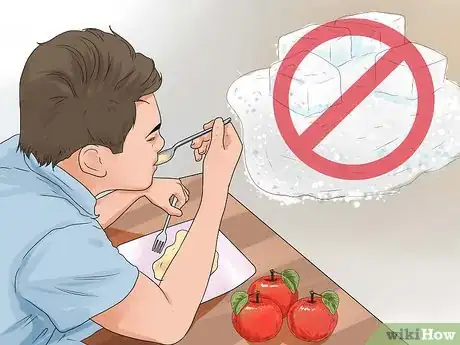
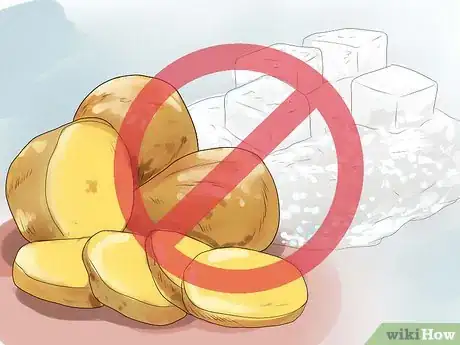


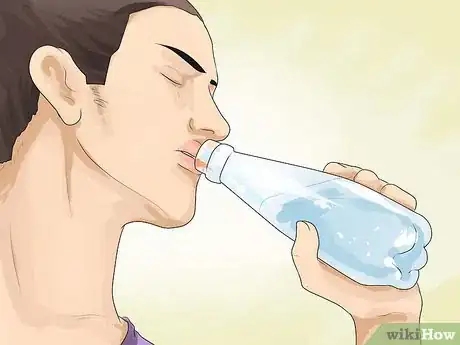


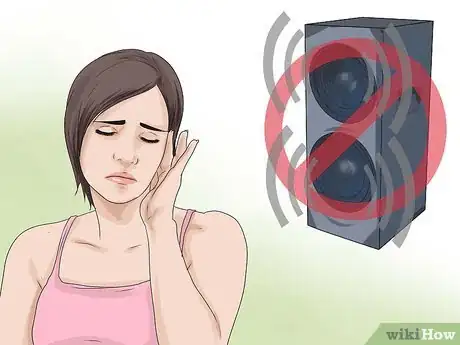

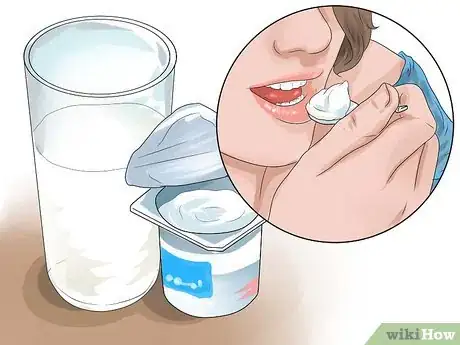


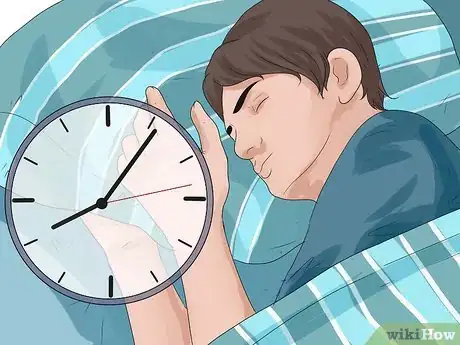
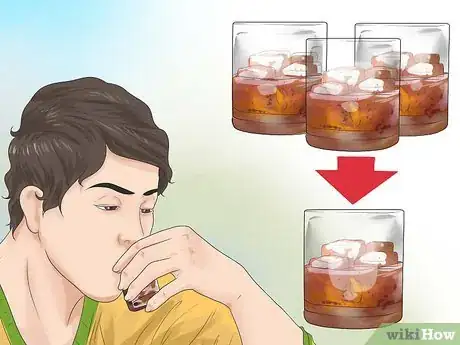

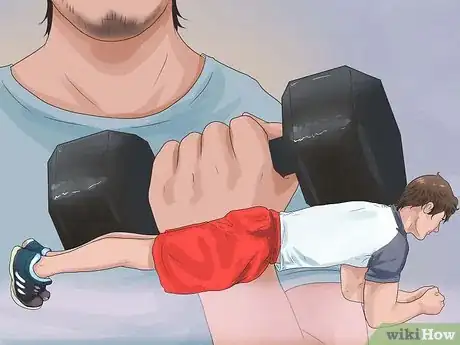
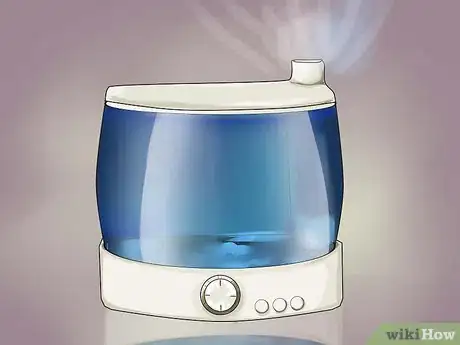
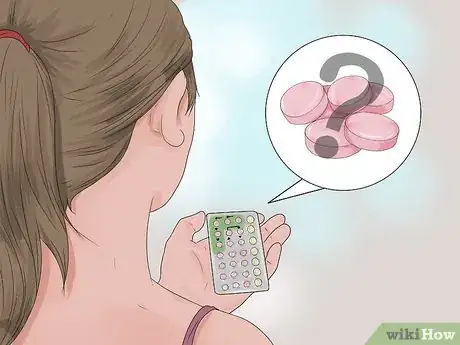
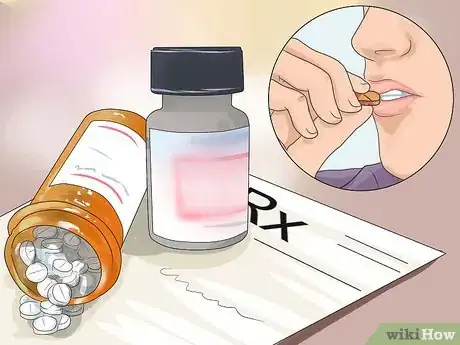
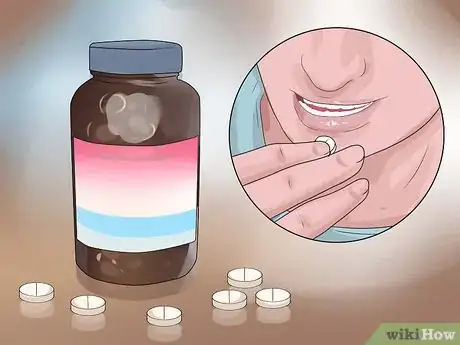
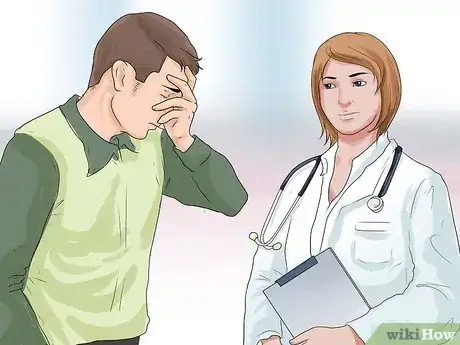
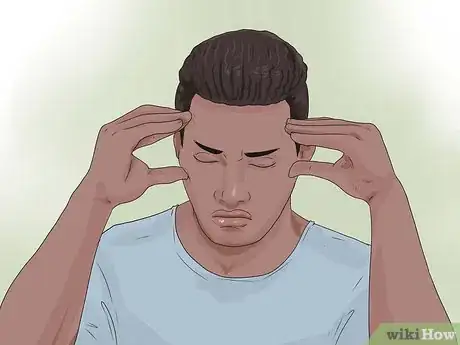

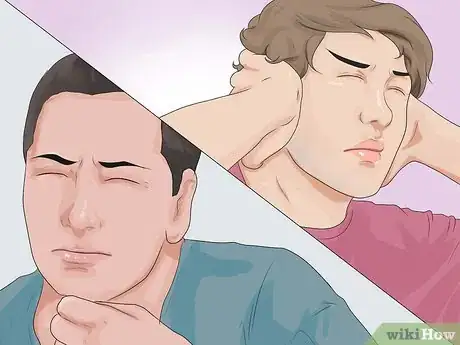
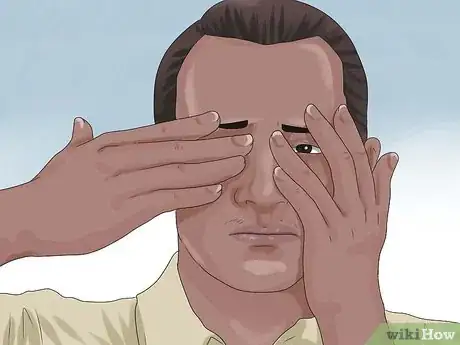

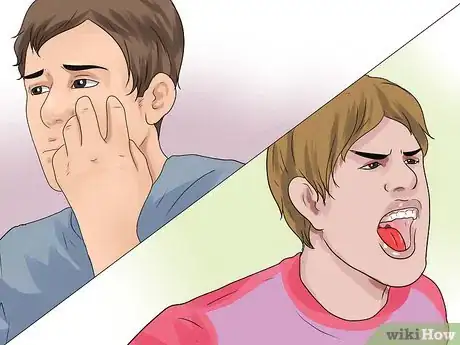





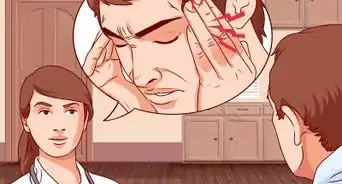

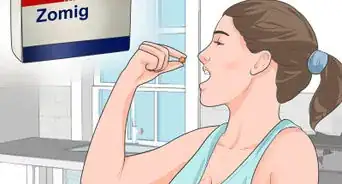















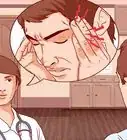




































Medical Disclaimer
The content of this article is not intended to be a substitute for professional medical advice, examination, diagnosis, or treatment. You should always contact your doctor or other qualified healthcare professional before starting, changing, or stopping any kind of health treatment.
Read More...